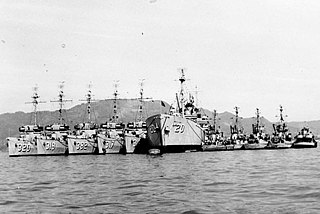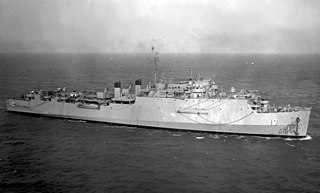
USS Duncan (DD-874) was a Gearing-class destroyer of the United States Navy, the third named for Captain Silas Duncan USN (1788–1834). The ship was laid down by the Consolidated Steel Corporation at Orange, Texas on 22 May 1944, launched on 27 October 1944 by Mrs. D. C. Thayer and commissioned on 25 February 1945. The ship was sunk in 1980.

USS Cabildo (LSD-16) was a Casa Grande-class dock landing ship of the United States Navy. She was named for The Cabildo in New Orleans, the old town hall and now a historical museum, where the formal transfer of the Louisiana Territory from France to the United States took place.

USS Mount McKinley (AGC-7/LCC-7) was the lead ship of the Mount McKinley class of amphibious force command ships. She was named after the highest mountain in North America. She was designed as an amphibious force flagship, a floating command post with advanced communications equipment and extensive combat information spaces to be used by the amphibious forces commander and landing force commander during large-scale operations.

USS Oglethorpe (AKA-100) was an Andromeda-class attack cargo ship in service with the United States Navy from 1945 to 1968. She was scrapped in 1969.

USS Winston (AKA-94/LKA-94) was an Andromeda-class attack cargo ship in service with the United States Navy from 1945 to 1957 and from 1961 to 1969. She was scrapped in 1979.

USS Alshain (AKA-55) was an Andromeda-class attack cargo ship in the service of the United States Navy. She was named after the star Alshain in the constellation Aquila, and served as a commissioned ship for 11 years and 9 months.

USS Pledge (AM-277) was an Admirable-class minesweeper built for the U.S. Navy during World War II. She was built to clear minefields in offshore waters, and served the Navy in the Atlantic Ocean and then was transferred to the North Pacific Ocean. She survived the world war and was awarded one battle star, but, during the Korean War, she struck a mine and was sunk. She received the Presidential Unit Citation for her Korean service.

USS Redstart (AM-378/MSF-378) was an Auk-class minesweeper commissioned by the United States Navy for service in World War II. Her task, as a fleet minesweeper, was to clear mines as the fleet proceeded into battle areas.

USS Ruddy (AM-380) was an Auk-class minesweeper acquired by the U.S. Navy for the dangerous task of removing mines from minefields laid in the water to prevent ships from passing. She was the only U.S. Navy ship named for the North American ruddy duck.

USS Impeccable (AM-320) was an Auk-class minesweeper built for the United States Navy during World War II. She was originally ordered as HMS Brutus (BAM-7) for the United Kingdom's Royal Navy under Lend-Lease, but was acquired and renamed by the United States Navy before construction began. She was commissioned in 1944 and served in the Pacific before being decommissioned in 1947. After the outbreak of hostilities in Korea, Impeccable was recommissioned in 1952 and served off Korea through 1952. She was decommissioned for the final time in October 1955 and placed in reserve. She was sold for scrapping in 1974.

USS Waxbill (MHC-50/AMCU-50/AMS-39/YMS-479/PCS-1456) was a YMS-1-class minesweeper of the YMS-446 subclass acquired by the U.S. Navy for the task of removing mines placed in the water to prevent ships from passing.

USS Kite was a YMS-1-class minesweeper of the YMS-135 subclass built for the United States Navy during World War II.

USS Litchfield County (LST-901) was a LST-542-class tank landing ship built for the United States Navy during World War II. Named after Litchfield County, Connecticut, she was the only U.S. Naval vessel to bear the name.

USS Epping Forest (LSD-4/MCS-7) was an Ashland-class dock landing ship acquired by the U.S. Navy during World War II for duty in the Pacific Theater. Her task was to carry and land amphibious landing craft and other equipment and to recover and repair landing craft when possible. Named for an estate in Lancaster County, Virginia where Mary Ball Washington, mother of George Washington, was born, she was the only U.S. Naval vessel to bear the name.

USS Bexar (APA-237/LPA-237) was a Haskell-class attack transport in service with the United States Navy from 1945 to 1970. She was scrapped in 1982.

USS Oak Hill (LSD-7) was an Ashland-class dock landing ship of the United States Navy, named in honor of Oak Hill, the Virginia estate of President James Monroe (1758–1831).

USS Catamount (LSD-17) was a Casa Grande-class dock landing ship of the United States Navy, named in honor of the Catamount Tavern in Old Bennington, which served as headquarters for Ethan Allen's Green Mountain Boys while making their plans against the New Yorkers and the British. The Catamount was also the meeting place of Vermont's only form of government then: the Vermont Council of Safety.

USS Comstock (LSD-19) was a Casa Grande-class dock landing ship of the United States Navy. She was the first navy ship named in honor of the Comstock Lode in Nevada, discovered in 1859, which was one of the richest deposits of precious metals known in the world.

USS Fort Marion (LSD-22) was a Casa Grande-class dock landing ship of the United States Navy. She was named for the Castillo de San Marcos in St. Augustine, Florida, which was named Fort Marion from 1821 till 1942.

USS Wantuck (APD-125) was a United States Navy high-speed transport in commission from 1944 to 1957.




















